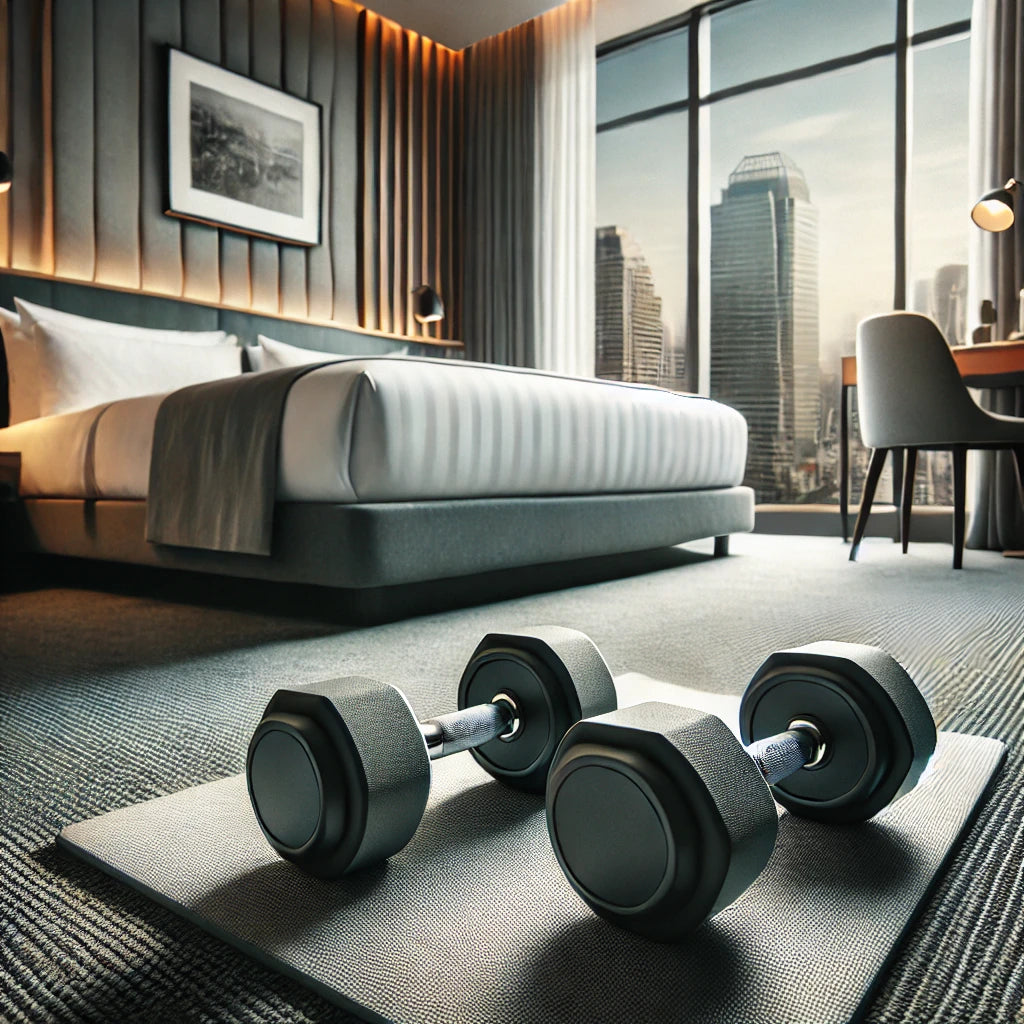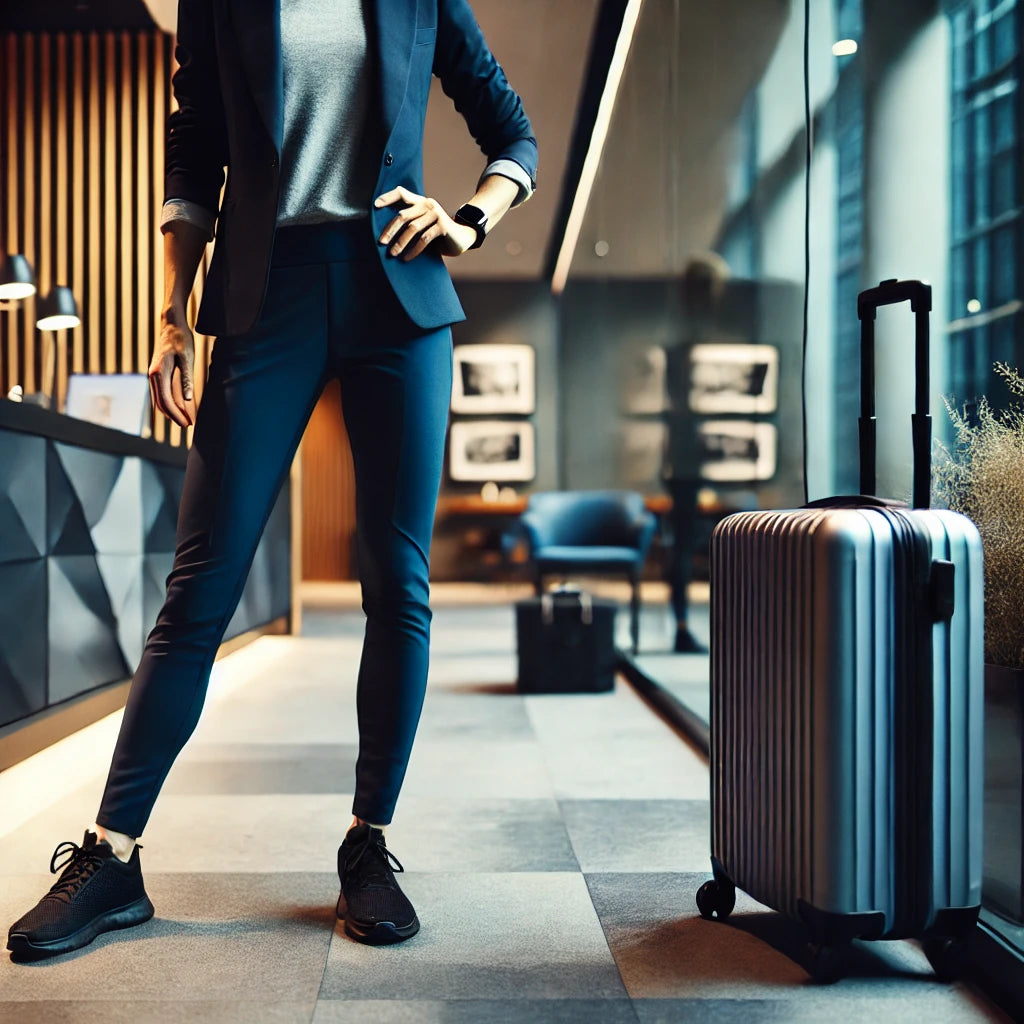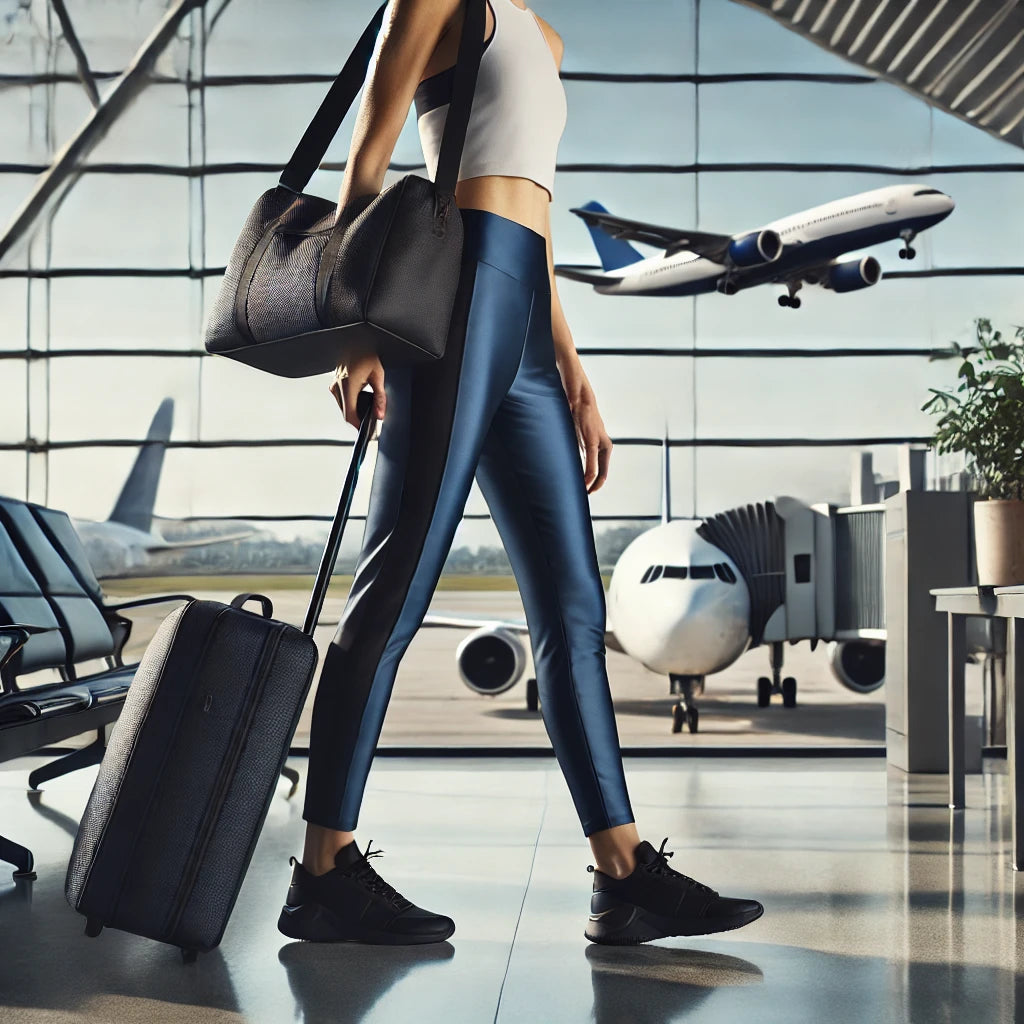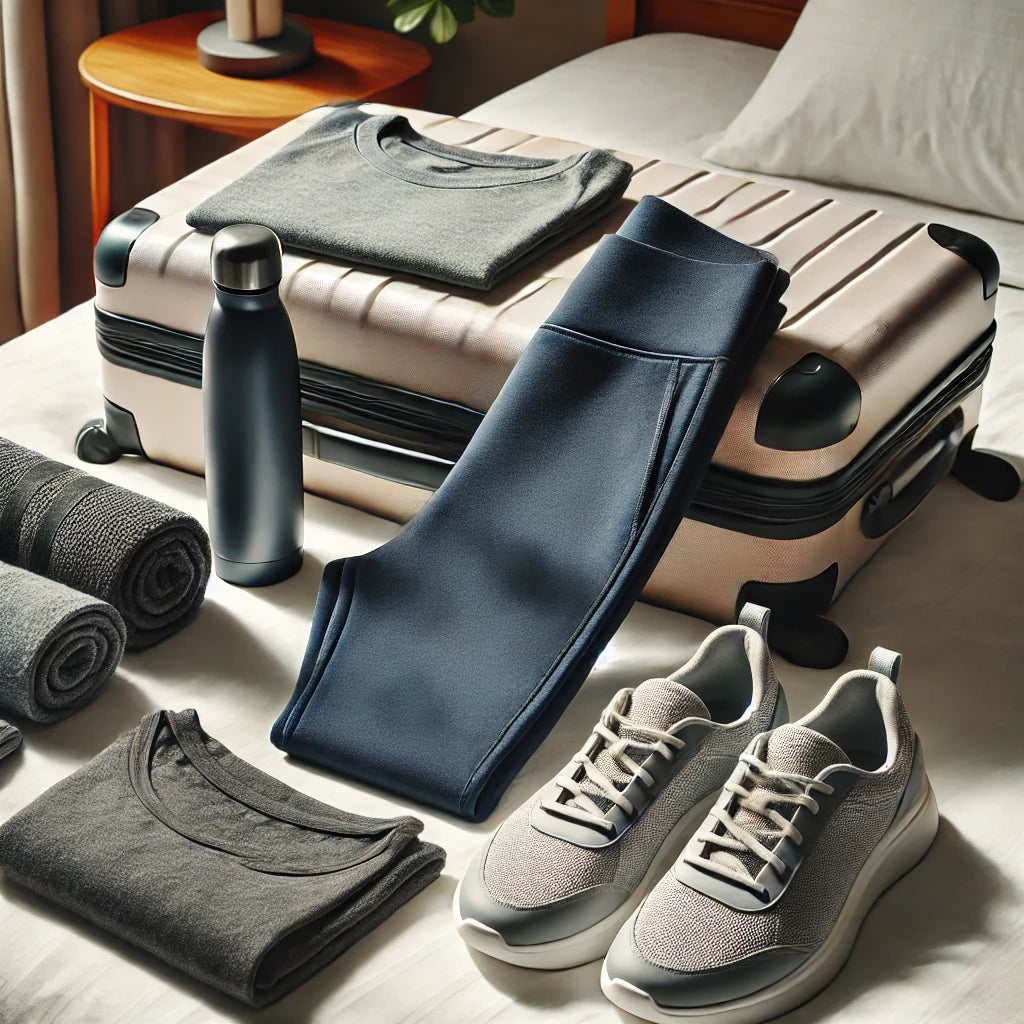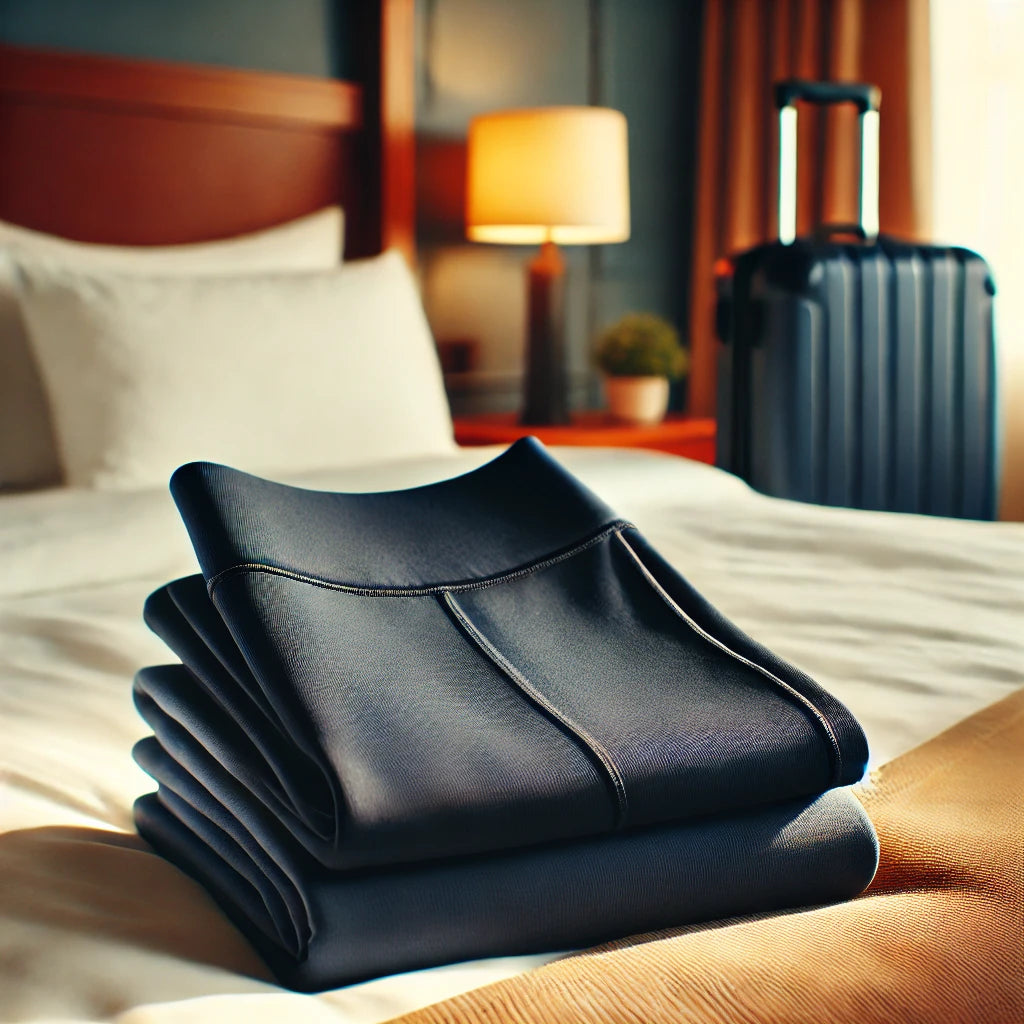Staying fit while traveling can be a challenge, but with the right strategies, it's entirely possible to maintain your fitness routine on the go. Our 3-day a week workout plan is specifically designed for busy traveling professionals like pilots, flight attendants, and travel nurses who often find themselves with limited time and space. This plan focuses on effective dumbbell workouts that can be performed in hotel rooms or small hotel gyms, ensuring you stay on track with your fitness goals no matter where your travels take you. Discover how to maximize your workouts and stay fit without sacrificing your professional commitments.

The Importance of Staying Fit While Traveling
Traveling professionals face unique challenges when it comes to maintaining their fitness routines. Long flights, irregular schedules, and limited access to fully equipped gyms can make it difficult to stay active. However, staying fit is crucial for maintaining energy levels, reducing stress, and preventing the negative health effects associated with a sedentary lifestyle.
Regular exercise helps improve cardiovascular health, boosts the immune system, and enhances mental well-being. For traveling professionals, who often experience disrupted sleep patterns and jet lag, maintaining a regular workout routine can help regulate sleep and improve overall mood and productivity.
Benefits of a 3-Day a Week Workout Plan
A 3-day a week workout plan offers several advantages for traveling professionals. Firstly, it is manageable and flexible, fitting easily into a busy travel schedule. This approach ensures you are still getting enough exercise without feeling overwhelmed or overcommitted.
Additionally, a structured 3-day plan allows for adequate recovery time between workouts, reducing the risk of injury and allowing muscles to repair and grow. This balance is especially important for those who may not have access to extensive gym facilities or who are performing exercises in confined spaces.
Workout Strategies for Small Spaces
One of the primary challenges for traveling professionals is finding suitable workout spaces. Hotel rooms and small hotel gyms can present limitations, but with the right exercises and equipment, you can still achieve a comprehensive workout.
- Dumbbell Workouts:
Dumbbells are versatile and portable, making them an excellent choice for travelers. They can be used to perform a wide range of exercises targeting all major muscle groups. Here are some effective dumbbell exercises you can incorporate into your routine:
- Dumbbell Squats: Great for targeting the legs and glutes.
- Dumbbell Press: Effective for working the chest and shoulders.
- Dumbbell Rows: Focus on the back muscles.
- Dumbbell Lunges: Engage the lower body, including quads and hamstrings.
- Dumbbell Curls: Isolate the biceps.
- Bodyweight Exercises:
Bodyweight exercises are ideal for small spaces as they require no equipment. They are also highly effective for building strength and endurance. Key bodyweight exercises include:
- Push-Ups: Target the chest, shoulders, and triceps.
- Planks: Strengthen the core and improve stability.
- Burpees: Provide a full-body workout and elevate heart rate.
- Mountain Climbers: Engage the core and lower body while improving cardiovascular fitness.
- Bodyweight Squats: Effective for lower body strength.
Sample 3-Day Workout Plan
Here’s a sample 3-day workout plan designed for traveling professionals. This plan incorporates both dumbbell and bodyweight exercises to ensure a comprehensive workout that can be performed in a hotel room or small gym.
Day 1: Upper Body Focus
- Warm-Up: 5-10 minutes of dynamic stretching or light cardio.
- Dumbbell Chest Press: 3 sets of 12 reps.
- Dumbbell Rows: 3 sets of 12 reps.
- Dumbbell Shoulder Press: 3 sets of 12 reps.
- Push-Ups: 3 sets of 15 reps.
- Planks: 3 sets of 1-minute holds.
Day 2: Lower Body Focus
- Warm-Up: 5-10 minutes of dynamic stretching or light cardio.
- Dumbbell Squats: 3 sets of 15 reps.
- Dumbbell Lunges: 3 sets of 12 reps per leg.
- Bodyweight Squats: 3 sets of 20 reps.
- Mountain Climbers: 3 sets of 1 minute.
- Calf Raises: 3 sets of 20 reps.
Day 3: Full Body and Cardio
- Warm-Up: 5-10 minutes of dynamic stretching or light cardio.
- Burpees: 3 sets of 15 reps.
- Dumbbell Deadlifts: 3 sets of 12 reps.
- Dumbbell Bicep Curls: 3 sets of 15 reps.
- Dumbbell Tricep Extensions: 3 sets of 15 reps.
- Bodyweight Circuits (e.g., 30 seconds each of push-ups, squats, and planks): 3 sets.

Tips for Staying Motivated
Staying motivated while traveling can be challenging, but incorporating the following strategies can help keep you on track:
- Set Realistic Goals:
Setting achievable goals is crucial for maintaining motivation. Whether it's maintaining your current fitness level, losing weight, or building muscle, having a clear goal will help you stay focused and committed.
- Plan Ahead:
Research hotel amenities and nearby fitness facilities before your trip. Knowing what options are available will help you plan your workouts in advance and avoid last-minute obstacles.
- Stay Accountable:
Consider sharing your workout plan with a friend or family member to help stay accountable. You can also use fitness apps or social media to track your progress and stay motivated.
- Pack Smart:
Bring along portable fitness equipment like resistance bands or a jump rope. These items take up minimal space in your luggage and can add variety to your workouts.
- Make Use of Your Environment:
Get creative with your surroundings. Use chairs for tricep dips, beds for incline push-ups, and walls for support during exercises like wall sits.
Nutrition Tips for Traveling Professionals
Maintaining a healthy diet is just as important as staying active. Traveling often means eating out frequently, which can make it challenging to stick to a nutritious diet. Here are some tips to help you make healthier choices on the go:
- Plan Your Meals:
Whenever possible, plan your meals ahead of time. Opt for healthier options like salads, grilled meats, and steamed vegetables. Avoid fried foods, sugary drinks, and excessive amounts of alcohol.
- Stay Hydrated:
Traveling can be dehydrating, especially during long flights. Drink plenty of water throughout the day to stay hydrated and avoid sugary beverages and excessive caffeine.
- Snack Wisely:
Pack healthy snacks like nuts, fruits, and protein bars to avoid the temptation of unhealthy airport or hotel vending machine options.
- Portion Control:
Be mindful of portion sizes, especially when eating out. Consider sharing meals or saving half for later to avoid overeating.
- Balance Your Meals:
Aim for a balanced diet that includes a mix of protein, carbohydrates, and healthy fats. This will help keep your energy levels stable and prevent cravings.
Overcoming Common Challenges
Traveling professionals often face unique challenges when it comes to maintaining their fitness and nutrition routines. Here are some common obstacles and strategies to overcome them:
- Limited Time:
When time is limited, prioritize high-intensity workouts that can be completed in a short period. Even a 20-minute workout can be effective if done with enough intensity.
- Jet Lag:
Jet lag can disrupt sleep patterns and make it difficult to stay motivated. Combat jet lag by staying hydrated, getting plenty of sunlight, and maintaining a consistent sleep schedule.
- Lack of Equipment:
If you find yourself without access to dumbbells or other equipment, focus on bodyweight exercises and use household items like water bottles as makeshift weights.
- Irregular Schedules:
Workouts don’t have to be done at the same time every day. Fit them in whenever you have a break, whether it’s early in the morning, during a lunch break, or in the evening.
- Mental Fatigue:
Traveling can be mentally exhausting. Use exercise as a way to refresh and rejuvenate. Even a short workout can boost your mood and energy levels.
The Role of Technology in Staying Fit
Technology can be a valuable ally in maintaining your fitness routine while traveling. Here are some tools and apps that can help you stay on track:
- Fitness Apps:
There are numerous fitness apps available that offer guided workouts, tracking, and motivation. Some popular options include MyFitnessPal, Nike Training Club, and FitOn.
- Wearable Devices:
Wearable fitness devices like Fitbit or Apple Watch can help you track your activity levels, monitor your heart rate, and set fitness goals.
- Online Workouts:
Many fitness trainers and gyms offer online workout classes that you can access from anywhere. These can be a great way to stay motivated and follow a structured workout plan.
- Nutrition Apps:
Apps like MyFitnessPal and Lose It! can help you track your meals, monitor your calorie intake, and ensure you’re meeting your nutritional goals.
Importance of Rest and Recovery
While staying active is crucial, rest and recovery are equally important, especially for traveling professionals who may be subject to physical and mental fatigue. Proper rest allows the body to repair and strengthen itself, which is essential for muscle growth and overall health. Here are some strategies to ensure you're getting adequate rest and recovery:
- Prioritize Sleep:
Quality sleep is fundamental to recovery. Aim for 7-9 hours of sleep per night. Use earplugs and a sleep mask if you’re in a noisy or bright environment. Consider travel pillows and blankets to enhance comfort.
- Stay Hydrated:
Dehydration can hinder recovery and exacerbate fatigue. Drink plenty of water throughout the day, especially before and after workouts.
- Stretching and Flexibility:
Incorporate stretching into your routine to enhance flexibility and reduce muscle tension. Yoga and Pilates are excellent options that can be done in a small space.
- Active Recovery:
On your rest days, consider engaging in low-intensity activities like walking, light cycling, or swimming. These activities promote blood flow and aid in recovery without putting additional strain on the body.
- Listen to Your Body:
Pay attention to signs of overtraining, such as persistent muscle soreness, fatigue, and decreased performance. If you experience these symptoms, it may be necessary to take additional rest days or reduce workout intensity.
Adapting to Different Hotel Amenities
Hotel amenities can vary greatly, and adapting to what’s available can help you maintain your fitness routine without interruption. Here’s how to make the most of different hotel amenities:
- Fully Equipped Gym:
If your hotel has a fully equipped gym, take advantage of the variety of equipment available. Use machines and free weights to vary your workouts and target different muscle groups.
- Limited Gym Facilities:
Many hotels have smaller gyms with limited equipment. Focus on dumbbell and bodyweight exercises, and use whatever equipment is available creatively. For example, a stability ball can be used for core exercises, and a bench can be utilized for step-ups or tricep dips.
- No Gym Facilities:
In the absence of a gym, workouts can be done entirely in your hotel room. Use bodyweight exercises and portable equipment like resistance bands. Furniture can serve as workout props; for instance, use a chair for step-ups or incline push-ups.
- Outdoor Spaces:
If the weather is nice, consider taking your workout outside. Many hotels have nearby parks or walking trails. Outdoor workouts can be refreshing and provide a change of scenery.

Sample Workouts for Different Scenarios
Below are tailored workout plans for various hotel scenarios, ensuring you stay fit no matter the amenities available.
Fully Equipped Gym Workout
Day 1: Strength Training
- Warm-Up: 5-10 minutes on a treadmill or elliptical.
- Bench Press: 3 sets of 12 reps.
- Lat Pulldown: 3 sets of 12 reps.
- Leg Press: 3 sets of 15 reps.
- Dumbbell Shoulder Press: 3 sets of 12 reps.
- Cable Rows: 3 sets of 12 reps.
- Cool Down: 5-10 minutes of light stretching.
Day 2: Cardio and Core
- Warm-Up: 5-10 minutes of dynamic stretching.
- Treadmill Run or Elliptical: 30 minutes.
- Plank: 3 sets of 1-minute holds.
- Bicycle Crunches: 3 sets of 20 reps.
- Russian Twists: 3 sets of 20 reps.
- Cool Down: 5-10 minutes of stretching.
Day 3: Full Body Workout
- Warm-Up: 5-10 minutes on a stationary bike.
- Dumbbell Squats: 3 sets of 15 reps.
- Deadlifts: 3 sets of 12 reps.
- Dumbbell Bench Press: 3 sets of 12 reps.
- Dumbbell Rows: 3 sets of 12 reps.
- Dumbbell Lunges: 3 sets of 12 reps per leg.
- Cool Down: 5-10 minutes of stretching.
Limited Gym Workout
Day 1: Upper Body
- Warm-Up: 5-10 minutes of dynamic stretching or light cardio.
- Dumbbell Chest Press: 3 sets of 12 reps.
- Dumbbell Rows: 3 sets of 12 reps.
- Dumbbell Shoulder Press: 3 sets of 12 reps.
- Push-Ups: 3 sets of 15 reps.
- Tricep Dips: 3 sets of 15 reps.
- Cool Down: 5-10 minutes of stretching.
Day 2: Lower Body
- Warm-Up: 5-10 minutes of dynamic stretching or light cardio.
- Dumbbell Squats: 3 sets of 15 reps.
- Dumbbell Lunges: 3 sets of 12 reps per leg.
- Bodyweight Squats: 3 sets of 20 reps.
- Calf Raises: 3 sets of 20 reps.
- Mountain Climbers: 3 sets of 1 minute.
- Cool Down: 5-10 minutes of stretching.
Day 3: Cardio and Core
- Warm-Up: 5-10 minutes of dynamic stretching.
- Jump Rope: 5 minutes.
- Burpees: 3 sets of 15 reps.
- Plank: 3 sets of 1-minute holds.
- Bicycle Crunches: 3 sets of 20 reps.
- Russian Twists: 3 sets of 20 reps.
- Cool Down: 5-10 minutes of stretching.
No Gym Facilities Workout
Day 1: Full Body
- Warm-Up: 5-10 minutes of dynamic stretching.
- Bodyweight Squats: 3 sets of 20 reps.
- Push-Ups: 3 sets of 15 reps.
- Lunges: 3 sets of 12 reps per leg.
- Plank: 3 sets of 1-minute holds.
- Burpees: 3 sets of 15 reps.
- Cool Down: 5-10 minutes of stretching.
Day 2: Upper Body
- Warm-Up: 5-10 minutes of dynamic stretching.
- Chair Dips: 3 sets of 15 reps.
- Incline Push-Ups (using the bed): 3 sets of 15 reps.
- Shoulder Taps: 3 sets of 20 reps.
- Arm Circles: 3 sets of 30 seconds.
- Cool Down: 5-10 minutes of stretching.
Day 3: Lower Body and Core
- Warm-Up: 5-10 minutes of dynamic stretching.
- Wall Sits: 3 sets of 1 minute.
- Bulgarian Split Squats (using a chair): 3 sets of 12 reps per leg.
- Glute Bridges: 3 sets of 15 reps.
- Bicycle Crunches: 3 sets of 20 reps.
- Cool Down: 5-10 minutes of stretching.
Mindfulness and Mental Health
Staying fit while traveling isn’t just about physical health; mental well-being is equally important. Travel can be stressful, and maintaining a mindfulness routine can help manage stress and enhance overall well-being. Here are some practices to incorporate:
- Meditation:
Set aside a few minutes each day for meditation. Use apps like Headspace or Calm to guide you through mindfulness sessions.
- Breathing Exercises:
Practice deep breathing exercises to reduce stress and anxiety. Techniques like box breathing (inhaling for 4 counts, holding for 4 counts, exhaling for 4 counts, and holding for 4 counts) can be calming.
- Journaling:
Keep a travel journal to document your experiences and thoughts. Journaling can be therapeutic and help you process your travels.
- Yoga:
Incorporate yoga into your routine to enhance flexibility, reduce stress, and promote relaxation. There are numerous online resources and apps that offer yoga sessions for all levels.
- Mindful Eating:
Practice mindful eating by savoring each bite and paying attention to your hunger and fullness cues. This can help you make healthier food choices and enjoy your meals more.

Staying Fit with Limited Resources
Traveling often means facing limitations in terms of time, space, and equipment. However, staying fit with limited resources is entirely possible with creativity and determination. Here are some strategies to make the most of what you have:
- Use Household Items:
Get creative with everyday items in your hotel room. Water bottles can serve as light weights, a sturdy chair can be used for step-ups or tricep dips, and a towel can be used for resistance exercises.
- High-Intensity Interval Training (HIIT):
HIIT workouts are effective and time-efficient, making them perfect for travelers. These workouts involve short bursts of intense activity followed by brief periods of rest. For example, 20 seconds of burpees followed by 10 seconds of rest, repeated for 4 minutes, can provide a full-body workout in a short amount of time.
- Utilize Technology:
There are numerous fitness apps and online resources that offer guided workouts you can do anywhere. Whether it’s a quick yoga session or a full-body strength workout, technology can help you stay on track.
- Resistance Bands:
Resistance bands are lightweight, portable, and versatile. They can be used to perform a wide range of exercises targeting all major muscle groups. Pack a set in your luggage for added workout variety.
- Stair Workouts:
If your hotel has stairs, incorporate them into your workout routine. Running or walking up and down stairs is an excellent cardiovascular workout and strengthens the legs and glutes.
Customizing Your Workouts
Customization is key to keeping your workout routine interesting and effective. Tailoring your workouts to your specific needs and preferences will help you stay engaged and motivated. Here are some ways to customize your workouts:
- Set Specific Goals:
Identify your fitness goals, whether it’s building strength, improving endurance, losing weight, or simply maintaining your current fitness level. Customize your workouts to align with these goals.
- Mix It Up:
Variety is crucial to prevent boredom and avoid plateaus. Mix up your workouts by incorporating different exercises, changing the order of exercises, or trying new workout styles like circuit training or HIIT.
- Adjust Intensity:
Depending on your energy levels and schedule, adjust the intensity of your workouts. On days when you’re feeling energetic, push yourself with higher intensity workouts. On days when you’re feeling fatigued, opt for lighter, low-intensity exercises.
- Include Enjoyable Activities:
Incorporate activities you enjoy to make your workouts more enjoyable. If you love dancing, include a dance workout. If you enjoy outdoor activities, incorporate hiking or jogging into your routine.
- Track Your Progress:
Keep track of your workouts and progress. Use a fitness app or journal to log your exercises, sets, and reps. Tracking progress helps you stay motivated and see how far you’ve come.
The Role of Diet in Fitness
Diet plays a crucial role in maintaining fitness, especially for traveling professionals who may face challenges in finding healthy food options. Here’s how to maintain a balanced diet while on the go:
- Balanced Meals:
Aim for balanced meals that include protein, carbohydrates, and healthy fats. Protein is essential for muscle repair and growth, carbohydrates provide energy, and healthy fats support overall health.
- Healthy Snacks:
Pack healthy snacks like nuts, seeds, fruit, and protein bars. These can be lifesavers when you’re on the go and don’t have access to healthy meal options.
- Portion Control:
Be mindful of portion sizes, especially when dining out. Restaurant portions can be large, so consider sharing meals or taking leftovers back to your hotel for another meal.
- Hydration:
Stay hydrated by drinking plenty of water throughout the day. Avoid sugary drinks and excessive caffeine, as they can lead to dehydration.
- Limit Processed Foods:
Processed foods are often high in unhealthy fats, sugars, and sodium. Whenever possible, opt for whole foods like fruits, vegetables, lean meats, and whole grains.
Practical Tips for Eating Healthy While Traveling
Eating healthy while traveling can be challenging, but with a bit of planning, it’s entirely possible. Here are some practical tips to help you make healthier food choices on the go:
- Research Ahead:
Before you travel, research the dining options available at your destination. Look for restaurants that offer healthy options and plan your meals accordingly.
- Grocery Shopping:
If your accommodation has a kitchenette, consider buying groceries and preparing some of your meals. This can save money and allow you to control the ingredients and portion sizes.
- Choose Wisely:
When dining out, choose dishes that are grilled, baked, or steamed rather than fried. Opt for salads with dressing on the side, and avoid dishes with heavy sauces or gravies.
- Watch Out for Hidden Calories:
Be mindful of hidden calories in dressings, sauces, and beverages. Ask for dressings and sauces on the side, and choose water or unsweetened beverages instead of sugary drinks.
- Practice Moderation:
It’s okay to indulge occasionally, but practice moderation. Enjoy a treat in small portions and balance it with healthier meals throughout the day.

Staying Active During Layovers
Layovers can be a great opportunity to stay active, especially if you’re facing long flights or waiting times. Here are some ways to incorporate physical activity during layovers:
- Airport Walks:
Many airports have designated walking paths or terminals that are ideal for getting in some steps. Walking is a great way to stay active and stretch your legs between flights.
- Stretching:
Take the opportunity to stretch during layovers. Find a quiet corner and perform simple stretches to relieve tension and improve circulation.
- Airport Gyms:
Some airports have gyms or fitness centers that offer day passes. If you have a long layover, consider using these facilities to get in a workout.
- Active Travel:
If your layover is long enough, consider exploring the city on foot. This can be a fun way to see new places while staying active.
- Mini Workouts:
Pack a resistance band in your carry-on and perform mini workouts in the airport. Simple exercises like squats, lunges, and resistance band rows can be done in a small space.
Using Hotel Room Furniture for Workouts
Hotel room furniture can be surprisingly useful for workouts. Here are some creative ways to use furniture to enhance your workouts:
- Chair Exercises:
Use a sturdy chair for exercises like tricep dips, step-ups, and incline push-ups. Chairs can also be used for seated leg raises and seated ab twists.
- Bed Exercises:
Beds can be used for incline push-ups, planks, and leg raises. Be sure the bed is stable and use it to vary the angle of your exercises.
- Wall Exercises:
Walls are great for exercises like wall sits, wall push-ups, and standing leg lifts. These exercises can be done in a small space and provide a good workout.
- Table Exercises:
A sturdy table can be used for bent-over rows and inclined planks. Ensure the table is stable and can support your weight before using it for exercises.
- Luggage Exercises:
Your suitcase can serve as a weight for exercises like Russian twists and suitcase swings. It can also be used for step-ups and to add resistance to bodyweight exercises.
Maintaining Consistency
Consistency is key to staying fit while traveling. Here are some tips to help you maintain a consistent workout routine:
- Set a Schedule:
Plan your workouts around your travel schedule. Aim to work out at the same time each day to build a routine.
- Stay Flexible:
While consistency is important, it’s also crucial to stay flexible. If you miss a workout, don’t get discouraged. Adjust your schedule and make up for it when you can.
- Use Reminders:
Set reminders on your phone or use a fitness app to keep track of your workouts. Reminders can help you stay accountable and ensure you don’t forget to exercise.
- Travel with a Buddy:
If possible, travel with a colleague or friend who is also interested in fitness. Having a workout buddy can provide motivation and make exercising more enjoyable.
- Reward Yourself:
Set small rewards for reaching fitness milestones. Whether it’s a massage, a favorite healthy treat, or a new piece of workout gear, rewards can help keep you motivated.
Overcoming Jet Lag with Exercise
Jet lag can be a significant challenge for traveling professionals. Exercise can play a crucial role in overcoming jet lag and adjusting to new time zones. Here’s how:
- Morning Workouts:
Morning workouts can help reset your internal clock and boost your energy levels for the day ahead. Exposure to natural light during a morning workout can also help regulate your sleep-wake cycle.
- Stay Active During the Flight:
On long flights, try to stay active by walking up and down the aisle and doing simple stretches. This can help reduce the stiffness and fatigue associated with long periods of sitting.
- Hydrate:
Staying hydrated is essential for reducing the effects of jet lag. Drink plenty of water before, during, and after your flight.
- Avoid Heavy Meals:
Avoid heavy meals close to your bedtime in the new time zone. Opt for light, healthy meals that are easy to digest.
- Short Naps:
If you need to nap, keep it short (20-30 minutes) to avoid interfering with your nighttime sleep.
Planning for Long-Term Fitness Success
Maintaining fitness while traveling requires long-term planning and commitment. Here are some strategies to ensure long-term success:
- Set Long-Term Goals:
In addition to short-term goals, set long-term fitness goals. Whether it’s running a marathon, achieving a certain weight, or improving overall health, long-term goals provide direction and motivation.
- Create a Fitness Travel Kit:
Assemble a fitness travel kit with essential items like resistance bands, a jump rope, and a yoga mat. Having these items on hand makes it easier to stay active wherever you go.
- Educate Yourself:
Stay informed about fitness and nutrition by reading books, following reputable fitness blogs, and attending workshops or seminars. Knowledge empowers you to make better choices and stay motivated.
- Connect with a Community:
Join online fitness communities or social media groups where you can share experiences, get advice, and find motivation from others who travel frequently.
- Regular Health Check-Ups:
Schedule regular health check-ups to monitor your progress and address any health concerns. Regular check-ups help you stay on track and ensure you’re maintaining good health.

Staying Fit During Busy Seasons
Traveling professionals often face peak seasons where schedules become even more hectic. Here’s how to stay fit during these busy times:
- Prioritize Short Workouts:
During busy periods, focus on shorter, high-intensity workouts. Even 15-20 minutes of exercise can be effective if done with intensity.
- Plan Ahead:
Look at your schedule in advance and identify pockets of time where you can fit in a workout. Even a few minutes here and there can add up.
- Use Bodyweight Exercises:
Bodyweight exercises are convenient and can be done anywhere without equipment. Focus on exercises like push-ups, squats, lunges, and planks.
- Stay Active in Small Ways:
Look for small ways to stay active throughout the day. Take the stairs instead of the elevator, walk instead of taking a taxi, or do a quick stretch during breaks.
- Prioritize Sleep:
Busy schedules can lead to sleep deprivation, which can hinder your fitness progress. Prioritize getting enough sleep to ensure you have the energy to stay active.
Utilizing Travel Time for Fitness Education
Travel time can be an opportunity to educate yourself about fitness and nutrition. Here’s how to make the most of your travel time:
- Listen to Podcasts:
Download fitness and nutrition podcasts to listen to during flights or long drives. Podcasts are a great way to learn new tips and stay motivated.
- Read Books or Articles:
Bring along fitness-related books or download articles to read during your trip. Continuous learning can provide new insights and keep you engaged in your fitness journey.
- Watch Videos:
If you have access to Wi-Fi, watch workout videos or fitness documentaries. Videos can provide visual demonstrations of exercises and new workout ideas.
- Take Online Courses:
Consider enrolling in online courses related to fitness, nutrition, or wellness. Many platforms offer courses that you can complete at your own pace.
- Reflect and Plan:
Use travel time to reflect on your fitness journey, assess your progress, and plan your future workouts and nutrition strategies.
Fitness Apps and Tools for Traveling Professionals
Leveraging technology can help you stay on track with your fitness goals while traveling. Here are some recommended apps and tools:
- MyFitnessPal:
A comprehensive app for tracking your meals, calories, and exercise. It also has a large database of foods and exercises.
- Nike Training Club:
Offers a variety of workouts that can be done anywhere, with options for different fitness levels and goals.
- FitOn:
Provides free, personalized workout plans and classes led by top trainers.
- Fitbit:
A wearable device that tracks your steps, workouts, sleep, and more. The accompanying app helps you set and achieve fitness goals.
- Headspace:
A meditation app that offers guided sessions to help reduce stress and improve mental well-being.

Conclusion
Staying fit while traveling requires planning, flexibility, and creativity. By incorporating a 3-day workout plan, adapting to different hotel amenities, and making mindful nutrition choices, you can maintain your fitness routine on the go. Remember to prioritize rest and recovery, stay motivated with customized workouts, and utilize technology to support your fitness journey. With these strategies, you can stay healthy, energized, and focused, no matter where your travels take you. Safe travels and happy workouts!
Read More
- Efficient 3-Day Workout Plans for Busy Professionals on the Go
- Maximize Your Fitness with 3-Day a Week Dumbbell Workouts for Travelers
- Effective Hotel Room Workouts: 3 Days a Week Fitness Routine
- Ultimate 3-Day Workout Schedule for Travel Nurses and Frequent Flyers
- Transform Your Body with 3-Day a Week Workouts: A Traveler's Guide
- 3-Day Workout Plans for Traveling Professionals: Stay in Shape Anywhere

